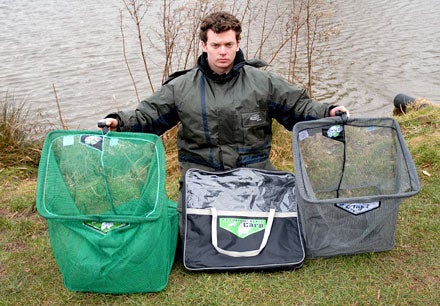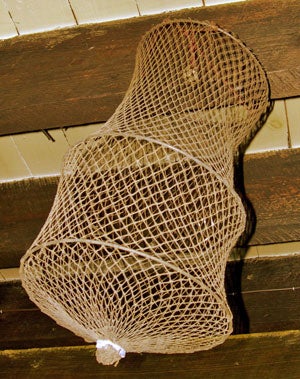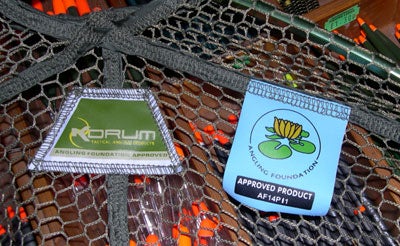| MARK WINTLE |
| Mark Wintle, an angler for thirty-five years, is on a quest to discover and bring to you the magic of fishing. Previously heavily involved with match fishing he now fishes for the sheer fun of it. With an open and enquiring mind, each week Mark will bring to you articles on fishing different rivers, different methods and what makes rivers, and occasionally stillwaters, tick. Add to this a mixed bag of articles on catching big fish; tackle design, angling politics and a few surprises. Are you stuck in a rut fishing the same swim every week? Do you dare to try something different and see a whole new world of angling open up? Yes? Then read Mark Wintle’s regular column. |
Keepnets Good but Could be BetterIN THE LAST three or four years the quality of keepnets has got a lot better for fish welfare for reasons that I’ll explain later. Can further improvements be made? I think so, and I’d like it to go one step further.
Those that know me well will know that despite my background as a match angler I’m no great fan of keepnets, but for match fishing they’re here to stay. In which case, I propose radical measures to make things better. I’ve been using keepnets since I first had a two-foot cotton one in the late sixties. That was bad but not as bad as the knotted nylon minnow-mesh one that followed. It was embarrassing to keep fish in it such was the state of fish kept in it. When Ray Field launched his micromesh knotless nets in 1974 (Graham was involved in the field testing) it was a massive improvement, and I’m pleased to say that I quickly got rid of the old net and got a new knotless micromesh one. Legislation later outlawed the abrasive knotted nets, and you’d think that all would be rosy for evermore.
The disadvantages of the original knotless nets were that 1) they were heavy when wet, and 2) even though the mesh was fine it still caught the dorsal fins of the increasingly popular small carp being stocked everywhere. Ultra fine mesh monofilament nets were developed in the early nineties but it became clear that some of these were abrasive to fins – not as bad as the old knotted nets, but still unacceptable. For a decade all manner of nets were put into use. Some were good, others unacceptably bad, yet all were legal.
Around three years ago, the Angling Foundation launched a net accreditation scheme showing a ‘Lily-Pad’ mark that is applied to nets that passed their testing. I commend this. Not all manufacturers have signed up yet. Some that haven’t merely state that their nets are EA byelaw compliant. But this does not prove their fish friendliness, although many of the unaccredited nets are OK, and would pass if subjected to the test. The success of the accreditation scheme means that new manufacturers continue to sign up to the testing, and more and more of the nets meet the new standard. There are two ways that this scheme could be improved
I would like to see the EA introduce a byelaw that enforces the above, but have the EA got the drive to take this forward? Who else can help? The SAA has an excellent Angling Code of Conduct. I would like the SAA to update the code on the above lines, and the NFA to advise their member clubs that it would make a lot of sense from a conservation point of view to enforce the above within their club rules. Sadly you will often find that many clubs do have a rule regarding keepnets but often the rule is decades out of date, and not even up to scratch regarding the latest legal position never mind the sort of standard that I am proposing. And it needs to be enforced! Those running day ticket waters where matches are held or keepnets may be used would do well to adopt this standard. At present, it only seems to be those fisheries within the Premier Fisheries UK organisation that are enforcing the Angling Foundation’s standard. I cannot comment to what extent that standard is enforced. As I’ve drawn heavily on the sterling work done by the Angling Foundation I hope they won’t mind me quoting from one of their articles as it says it all. “There are wider implications that stem from the nets accreditation scheme. Here is an excellent example of how a sport can recognise a problem, take decisive action and improve matters within a short space of time. It broadcasts a strong message to those who might wish to impose restrictions on angling that the sport can indeed ‘put its own house in order’ through the combined, concerted efforts of manufacturers, fishery owners and anglers themselves. That message has been recognised and acknowledged at the highest levels! The Angling Foundation itself is a non-profit making organisation. The fees that it derives from its members and from product testing have helped promote the scheme – so it is financially self-sufficient – and any surplus is ploughed back into the sport via educational and conservation initiatives. That’s good for fish… and good for angling.” |













